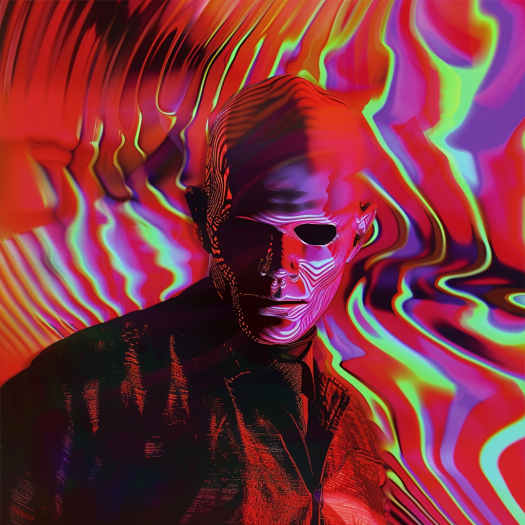Introduction
On November 22, 1987, Chicagoans were stunned when an unidentified person wearing a Max Headroom mask hijacked two television broadcasts. The first interruption was brief, during the sports segment on WGN-TV Channel 9. Later, a more extended intrusion occurred during a broadcast of “Doctor Who” on PBS affiliate WTTW Channel 11. The masked figure made bizarre comments, displayed erratic behavior, and ended with a bizarre spanking scene. Despite investigations by the FCC and FBI, the intruder’s identity and motives remain unknown, making it one of television’s most mysterious and eerie moments.
The Intrusions
First Interruption: WGN-TV Channel 9
- Time and Program: The first signal intrusion occurred around 9:14 PM during the sports segment of the WGN-TV Channel 9 news broadcast.
- Content: The broadcast was briefly interrupted by a person wearing a Max Headroom mask and sunglasses, standing in front of a moving corrugated metal background mimicking the effects used in the Max Headroom TV show.
- Duration: The interruption lasted approximately 25 seconds before the station’s engineers regained control of the broadcast.
Second Interruption: WTTW Channel 11
- Time and Program: The second and more infamous intrusion happened around 11:15 PM during an episode of “Doctor Who” on PBS affiliate WTTW Channel 11.
- Content: This intrusion lasted about 90 seconds. The masked figure delivered a series of bizarre and nonsensical statements, hummed the “Clutch Cargo” theme song, and displayed erratic behavior. The broadcast ended with a disturbing scene of the figure being spanked with a flyswatter by an unidentified accomplice.
- Viewer Reactions: Many viewers who were watching “Doctor Who” were confused and disturbed by the sudden and strange broadcast interruption.
Investigations
FCC and FBI Involvement
- Initial Response: Both the Federal Communications Commission (FCC) and the Federal Bureau of Investigation (FBI) launched investigations into the incident. Signal hijacking is a federal crime, and such an intrusion indicated a serious breach in broadcast security.
- Technical Details: It was determined that the intruder likely used a powerful transmitter to override the stations’ signals, indicating a certain level of technical expertise.
Challenges in the Investigation
- Technical Complexity: The technical aspects of the intrusion, such as the need for precise equipment and knowledge, suggested that the perpetrator had a high level of technical skill. However, tracing the source of the transmission proved difficult.
- Lack of Evidence: No physical evidence or clear leads emerged, and the disguised nature of the intruder (wearing a mask and disguising their voice) hindered identification efforts.
Theories and Speculations
Pranksters with Technical Skills
- Amateur Hackers: Some theories suggest that the intruders were likely pranksters or amateur hackers with a strong understanding of broadcast technology. The choice of the Max Headroom character, a well-known satirical TV persona, supports the idea of a prank with cultural commentary.
Inside Job
- Knowledgeable Insiders: Another theory posits that the perpetrators could have been broadcast industry insiders or former employees who had access to and knowledge of the necessary equipment and frequencies.
Political or Social Commentary
- Subversive Message: Some speculate that the broadcast could have been a form of social or political commentary, using the Max Headroom character’s anti-establishment image to criticize mainstream media and television.
Cultural Impact and Legacy
Pop Culture Phenomenon
- Enduring Fascination: The Max Headroom broadcast intrusion remains a topic of fascination and discussion in popular culture. It has been featured in numerous articles, documentaries, and TV shows, highlighting its place in broadcast history.
- Influence on Media: The incident has influenced various forms of media, inspiring plotlines in TV shows and movies centered around broadcast hijacking and media manipulation.
Unsolved Mystery
- Enduring Enigma: Despite the passage of decades, the Max Headroom broadcast intrusion remains unsolved. The identity and motives of the perpetrators are still unknown, adding to the incident’s mystique and intrigue.
- Speculative Theories: The lack of resolution has led to numerous speculative theories and urban legends, further cementing its status as a mysterious and eerie event in television history.
Conclusion
The Max Headroom broadcast intrusion of 1987 is one of the most bizarre and enigmatic incidents in television history. Despite extensive investigations by the FCC and FBI, the identity and motives of the masked intruder remain unknown. The incident continues to captivate and perplex those who study it, embodying a unique blend of technical audacity and cultural commentary. As an enduring mystery, it reminds us of the vulnerabilities in our broadcast systems and the limitless curiosity it sparks in those who seek to uncover its secrets.
FAQs
What happened during the Max Headroom broadcast intrusion?
On November 22, 1987, an unidentified person wearing a Max Headroom mask hijacked two television broadcasts in Chicago, delivering bizarre and nonsensical statements before the broadcasts were cut off.
Which channels were affected by the intrusion?
The intrusion affected WGN-TV Channel 9 during a sports segment and WTTW Channel 11 during an episode of “Doctor Who.”
How long did the intrusions last?
The first interruption on WGN-TV lasted approximately 25 seconds, while the second intrusion on WTTW Channel 11 lasted about 90 seconds.
Who was behind the Max Headroom broadcast intrusion?
The identity of the intruder remains unknown. Despite investigations by the FCC and FBI, no suspects were identified, and the case remains unsolved.
What theories exist about the broadcast intrusion?
Theories range from amateur hackers and pranksters with technical skills to insiders in the broadcast industry. Some believe the intrusion was a form of social or political commentary using the Max Headroom character’s anti-establishment image.
Why is the Max Headroom incident significant?
The incident is significant due to its audacity, technical complexity, and enduring mystery. It remains a fascinating topic in popular culture and serves as a reminder of the potential vulnerabilities in broadcast systems.

